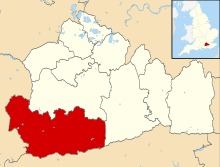Wormley, Surrey
Coordinates: 51°08′10″N 0°38′47″W / 51.1362°N 0.6464°W
Wormley is a village in Surrey, England. It is a dispersed community largely consisting of a scattering of houses on the A283 Petworth Road between Witley and Chiddingfold and Combe Lane, a turning off the A283 where Witley station and further houses are situated. Part of the village is in the census area of Witley and part in that of Chiddingfold.
The name derives from the Old English wyrm, snake, and leah, clearing.[1]
Wormley developed primarily as a result of the construction of Witley station, in the 19th century, on the main London Waterloo to Portsmouth line. Its best known building is probably King Edward's School, Witley and it was also the location for Cooper & Sons Ltd walking stick factory which has now been replaced by houses and a light industrial estate. The Institute of Oceanographic Sciences Deacon Laboratory was based in Wormley.
A number of the older houses in Wormley were designed by Gertrude Jekyll. George Eliot is a notable former resident, as is Louis de Bernières who based his collection of short stories, Notwithstanding,[2] on Wormley and the local area. De Bernières muses whether Wormley is, or is no longer, the rural idyll. Gertrude Mary Tuckwell lived the last twenty years of her life in Little Woodlands, Combe Lane, Wormley.
Wormley's only public house, the Wood Pigeon, closed in 2007.[3]
References
- ↑ "Wormley Family History". Ancestry.
- ↑ De Bernières, Louis: Notwithstanding (Vintage 2010) ISBN 0099542021
- ↑ The Lost Pubs Project

